This article is much longer than what I intended, but I hope that you enjoy it. It’s got a whole bunch of good stuff, and some really hidden treats that (I hope) will have you all running back for more. When you make the muffins, please make sure that you use real butter and make sure that they are hot right out of the oven! It’s a word to the wise, eh?
The Answer is the Coming Small-Town Revival
The post-COVID recovery will be change, not restoration. We’ll be forced to rebuild where we are.
From HERE
Years ago, I moved from a somewhat larger small town (pop. 30,000) in upstate New York to a smaller small town (pop. 2,500) 15 miles east in order to establish a little homestead with gardens, fruit trees, and chickens. I found this three-acre property literally on the edge of town, a five-minute walk to the center of Main Street.
If you’ve been following this column on urban design the past year, you know I’ve said we’re entering an era of stark economic contraction that will change the terms of daily life in America, and one feature of it is that the action will shift from the big cities and sprawling suburbs back to America’s small towns.
The COVID-19 virus has accelerated this trend, actually drawing a sharp dividing line between “then” and “now” that historians will recognize—but that many contemporary observers are missing.
My little town was badly beaten down when I got here in 2011 and actually sank a bit lower over the years since.
The last Main Street shops that sold anything not previously owned shut down. The two last suppertime restaurants folded. The tiny local newspaper ceased publication, and the DOT put a concrete barrier across the tracks of the little railroad spur line, which hadn’t run trains, anyway, since the 1980s.
The several factories on the river that runs through town—a tributary of the mighty Hudson—had all shuttered in the 1970s, and only one even still stands in the form of ruins, the rest demolished, wiped off the map and out of memory.
In the century and a half previous, they’d gone through iterations of making textiles—first linen, which was grown here, then cotton, which was not—and then paper products (finally, and not without irony, toilet tissue).
What’s left in the town is a phantom armature of everyday life tuned to a bygone era with all its economic and social functionality removed, like a fine old piano with all its string cut.
The bones are still there in the form of buildings, but the activities, relationships, and institutions are gone.
The commerce is gone, the jobs are gone, the social and economic roles have no players, the places for fraternizing and public entertainment gone, the churches nearly empty.
There’s a post-1980 shopping strip on the highway leaving the west end of town.
That’s where the supermarket is (it replaced a 1960s IGA closer to the center, which replaced the various greengrocers, butchers, and dry goods establishments of yore on Main Street).
There’s a chain pharmacy, a Tractor Supply, a pizza shop and a Chinese take-out place out there, too.
The Kmart closed in 2017 and two years later a Big Lots (overstocked merch) took its place.
The local school system may be the town’s largest employer these days; it’s also the town’s leading levier of taxes.
Some people drive long distances to work in other towns, even as far as the state capital, Albany, where jobs with good pay, real medical benefits, and fat pensions still exist—though you can’t claim they produce anything of value.
Quite a few people scrambled for years with marginal small home-based businesses (making art, massage, home bakeries, etc.), but the virus creamed a lot of them.
It’s hard these days to find a plumber or a carpenter.
A few dozen farmers hang on.
There is a lively drug underground here, which some can make a living at—if they can stay off their own product—but it’s not what you’d call a plus for the common good.
Federal cash supports of one sort or other account for many of the rest who live here: social security, disability, SNAP cards, plain old family welfare payments, and COVID-19 checks (for now), adding up to a quasi-zombie economy.
In short, what appears to be a town now bears no resemblance to the rich set of social and economic relationships and modes of production that existed here a hundred years ago, a local network of complex interdependencies based on local capital and local resources—with robust connections (the railroad! The Hudson River and Champlain Canal!) to other towns that operated similarly, and even linkage to some distant big city markets.
The question I’m building up to is:
How do we get back to anything that resembles that kind of high-functioning society?
The answer is trauma, a set of circumstances that will disrupt all the easy and dishonest work-arounds which have determined the low state of our current arrangements.
You can be sure this is coming; it’s already in motion:
- collapsing oil production due to the insupportable costs of the shale “miracle,”
- the end of industrial growth as we’ve known it,
- the limits of borrowing from the future to pay today’s bills (i.e., debt that will never be paid back),
- widespread household bankruptcy and unemployment,
- and the consequent social disorder all that will entail.
That reality will compel us to reorganize American life, starting with how we inhabit the landscape, and you can bet that three things will drive it:
- the necessity to produce food locally,
- the need to organize the activities that support food production locally,
- and the need—as when starting anything—to begin at a small and manageable scale.
It will happen emergently, which is to say without any committee of experts, savants, or commissars directing it, because the need will be self-evident.
For now, the broad public remains bamboozled, distracted by the terrors of COVID-19, the uproars of race-and-gender tension, the dazzle of Federal Reserve hocus-pocus, the anxiety over climate change, and, of course, the worsening struggle of so many ordinary citizens to just keep paying the bills.
When you’re in a ditch, you don’t call the President of the United States. You need a handful of friends and neighbors with a come-along.
That’s how it’s going to work to bring our small towns back to life.
When the chain stores choke on their broken supply chains, some attentive persons will see an advantage in figuring out how to get and sell necessities by rebuilding local networks of supply and retail.
Farming will be rescued from its artificially induced senility when the trucks stop delivering pallets of frozen pizza and Captain Crunch as dependably as they used to.
And then the need for many other businesses that support farming and value-added production will find willing, earnest go-getters.
The river still runs through town and it runs year-round, powerfully enough to make some things, if there was a reason to, and a will, and a way.
And after a while, you’ll have a fully functioning town again, built on social and economic roles that give people a reason to think that life is worth living.
Wait for it.
I completely endorse this thought and prediction. -MM
America declares war on China
From HERE.
US secretary of state declares China the “most serious long-term challenge” Despite the eruption of military conflict between the United States and Russia over Ukraine, the central aim of US foreign policy is to [1] cripple, [2] isolate and [3] contain China, US Secretary of State Antony Blinken said in a major policy speech Thursday. Blinken’s remarks, which have been delayed for months following the eruption of the war in Ukraine, represent a public presentation of the Biden administration’s internal strategy document on China, which declares that Beijing is the central target of the US military. “Even as President Putin’s war continues, we will remain focused on the most serious long-term challenge to the international order—and that’s posed by the People’s Republic of China,” Blinken said. He continued, “China is the only country with both the intent to reshape the international order and, increasingly, the economic, diplomatic, military, and technological power to do it.” “We will defend our interests against any threat,” Blinken said. Although he did not use the term, Blinken’s statement embraces the framework of economic “decoupling” developed under Trump. Blinken explicitly repudiated the efforts by the Nixon administration to engage with Beijing. The “China of today is very different from the China of 50 years ago, when President Nixon broke decades of strained relations to become the first US president to visit the country,” he declared. Blinken continued, “Now, China is a global power with extraordinary reach, influence, and ambition. It’s the second largest economy… it seeks to dominate the technologies and industries of the future. It’s rapidly modernized its military and intends to become a top tier fighting force with global reach. And it has announced its ambition to create a sphere of influence in the Indo-Pacific and to become the world’s leading power.” Blinken’s statement constitutes yet another embrace of the central foreign policy aim of the Trump administration: preparations for conflict with China. Notably, Blinken invoked the racist conspiracy theory developed by the Trump administration, that COVID-19 was a man-made virus, condemning China’s alleged efforts to block an “independent inquiry into COVID’s origin.” Modeling his tone and delivery on the rhetoric of former President Obama, Blinken repeatedly made completely contradictory assertions with a straight face. Blinken delivered blood-curdling threats, followed immediately by a declaration that the United States is not threatening anyone.
The war declaration is treated as a “nothing burger” in the United States
From HERE.
Blinken China policy speech: Nothing new to see here The Secretary’s remarks were a rehash of old statements and the usual mixed messages about US competition with Beijing. Secretary of State Antony Blinken delivered a frankly underwhelming address outlining the Biden administration’s policy towards China on Thursday. The speech at George Washington University had been scheduled for earlier in the month, but it was postponed because Blinken tested positive for COVID the day before he was set to give it. Coming on the heels of Biden’s visit to Asia and his controversial remarks committing the U.S. to intervene to defend Taiwan, Blinken’s speech offered little more than a rehashing of previous administration statements. Administration officials had of course emphasized to reporters in the weeks leading up to the speech that it would not contain any new announcements, and it did not. The speech served mainly as an occasion to give an overview of Biden’s China policy without providing much useful detail of how they intend to execute it. Biden’s China policy is modeled closely on that of the Trump administration, and it is arguably the one policy where there is the greatest continuity between Biden and his predecessor. There is good reason why Biden’s policy so far has been perceived as little more than “Trump lite”: not only are there very few substantive changes from the previous administration’s approach, but the Biden administration also fails to emphasize the differences that do exist.
- Written by Eamon McKinney
It was some twenty years after the end of the Vietnam war that a security conference was held between leading military figures from both America and Vietnam. Following the conference a U.S. Air Force General approached a Vietnamese General.
The American had been a fighter pilot captain during the conflict, the Vietnamese general had been a Colonel in the N.V.A. The American asked (paraphrasing): “You have to tell me, we knew your Army was continually crossing the Mekong, we flew sorties up and down the river and could never find your bridges.” “I know,” said the Vietnamese, “we built them three feet under water.”
In that instant the American understood why America lost the war. His “Road to Damascus” moment was informed by how the different combatants approached problems. Had that been an American problem, how an Army crosses a wide, deep and fast flowing river, they would have solved the problem differently. They would have built a suspension bridge, they would have had bases on either side to protect it. They would have had Bowling alleys and Burger Kings and would have been flying in Bob Hope to entertain the troops. Why? Because they could, when you have resources they become the answer to every problem. The Vietnamese didn’t have resources, so they were resourceful.
And that, as the American realized, was why the Vietnamese won, and America lost.
The general may have learned a lesson, but if he told anyone, no one listened. Many of the same mistakes were repeated in Afghanistan, with the same results. Resources are not the answer to every problem. As with Americas war on drugs, war on crime, war on poverty, all resources do is obscure the underlying problem and present false, ineffective solutions.
War, and the threat of war is America’s solution to everything. To the man with the hammer, every problem is a nail. America does indeed have a formidable war machine. However, as with all machines it requires fuel to run it, that fuel is the U.S. dollar. Since the Bretton Woods accord at the end of WWII, America has had the privilege of possessing the world’s reserve currency. This enabled America to dictate to all countries outside the Soviet bloc how the global financial system would work. The so-called “free world” was anything but free, it was handcuffed by a system that effectively exercised control over their domestic economies.
In 1973 Richard Nixon took the dollar off the gold standard, much to the chagrin of the rest of the world. Despite protests no country was in a position to do much about it. Under its proxies, the IMF and World Bank, it enslaved much of the developing world and prevented it from post-colonial development. The resentment towards America and the weaponisation of its dollar resource should not be underestimated.
Iraq had resources, mainly oil, but what should have been a blessing for the country turned into a curse. Saddam Hussein decided to break from the petrodollar system and sell his oil in other currencies, we all know how that turned out. Similarly, when Ghadafi decided to sell his oil in the newly launched gold-backed dinar, it turned out badly for him and the Libyan people too. Both countries were deliberately destroyed, Tripoli, the once vibrant capital city of Africa’s most prosperous country, now has open slave markets. None should doubt how seriously America takes the subject of the dollar. These were lessons learned by national leaders everywhere. For those curious as to why America needs 1000 foreign military bases in more than 100 countries, that’s why, so no country attempts to stray from the dollar plantation.
The trillions of foreign debt owed by America was never intended to be repaid, just rolled over indefinitely. Fair to say, most countries understand that the monies they were compelled to invest in U.S. treasuries is a sunk cost, and they are not getting it back. With every turn of the printing press the dollar further loses credibility and the asset value of their holdings diminishes further. Every country is looking for alternative ways of doing business that don’t involve the dollar. China and Russia, China and Iran and China with many of its Asian neighbours have been using reciprocal currencies for several years. This amounts to trillions in trade that the Dollar is no longer a party too. Once this is understood it can help provide a context for current events.
Russia has complete control over its central bank and minimal foreign debt. It also possesses immense gold reserves. President Putin has wisely made Russia virtually “sanction proof”. Sure, the West can sanction a few overseas oligarchs, but who cares? Not the Russian people. Removing Russia from the SWIFT payment system will result in come short-term inconvenience, but alternatives are available. Both Russia and China have developed their own interbank payment systems and are now making them available to other countries who wish to by-pass the dollar altogether.
The use of the dollar as a weapon of war has worked well for America, until now. But when a country becomes overly reliant on its resources, it becomes a “one trick pony”, see Saudi Arabia. Stripped of oil, what kind of economy would the Saudis have? They wouldn’t have one at all. America stripped of its unique resource will be in the same position.
The dollar could crash any day, the government has long known this. A government-issued digital currency is planned to replace it. That may work in America, but few countries will want to entangle themselves in another American-dominated financial system. The resource is running dry, and American leadership shows no sign of any resourcefulness.
Interesting times…
The United States is freaking out that resources, and trade are controlled by “enemies”…
From HERE
While proponents of renewables — including President Biden, top White House officials and Democratic lawmakers — have suggested that Russia’s invasion of Ukraine has shown the foolishness of relying on fossil fuels, the crisis has also roiled green tech. Renewable technology such as wind turbines, solar panels, industrial-scale battery storage and electric vehicles require a wide range of critical minerals sourced from around the world. Russia, China and other hostile nations control most of the global critical mineral supply chain, according to a 2021 White House report on supply chains. Following the invasion of Ukraine, the price of nickel surged more than 100%, reaching $100,000 per metric ton because of the threat of sanctions on Russian commodity markets. “The media hasn’t covered the cost of nickel, cobalt, aluminum, manganese or lithium,” Kish told the DCNF. “Lithium batteries, for example — if you want to call gasoline the fuel of internal combustion engines, lithium is the fuel of electric vehicles.” Recent volatility in commodity markets triggered by the Ukraine crisis, though, could “engender potentially long-lasting change,” according to Wood Mackenzie.
4 Minute Video of Actual TRENCH FIGHT Between Russian and Ukraine Soldiers – Brutal Bravery
The ongoing Special Military Operation by Russia into Ukraine, is accurately described as “war.” We’ve all seen the images and the videos, but few have ever caught the actual moments of bravery by BOTH sides. The 4m20s video below shows it for all to see. Russian soldiers entering a Ukrainian army TRENCH. The bravery by both sides is stunning. The killing is up-close and real. This is the reality of actual war.
The video begins with an aerial drone view of a trench, which – for the purposes of this description – I will refer to as a north-south trench line. Russian soldiers enter from the south. Ukrainians are along the way toward the north.
As the Russian move slowly northward, Ukrainians begin to move southward. Think about the actual bravery it takes for men on BOTH sides to do what you will see being done. The bravery of knowing there are armed men facing you in that very trench, and either you kill them, or they will kill you . . . . and yet soldiers from BOTH sides proceed along anyway. THAT, ladies and gentlemen, is effin bravery.
As the Russians move northward and the Ukrainians move southward, they cannot see each other for a bit. Once they get within eye sight, oh dear God how brutal it gets.
The first two soldiers catch a glimpse of each other and shots get fired. The Ukrainian retreats northward, to no avail. Fractions of a second later, he goes down. Shot. Dead.
Other Ukrainians, in side trenches off the main trench, then one-by-one, engage the advancing Russians. Machine gun fire hits the sides of the trench. Grenades get hurled, but most miss.
The battle goes on.
At one point, a grenade lands within arms reach of a Ukrainian; he grabs it and throw it OUT of the trench just in time to save his own life. Then another.
Then . . . the grenades hit their mark. The Ukrainians are killed.
It only last four minutes and twenty seconds. But the sheer bravery of men on BOTH sides is amazing. While I support RUSSIA, I have an amazing respect for men on BOTH sides. True bravery exists on BOTH sides. They know death is coming for them, yet they proceed nonetheless. And some of them die nonetheless.
This is actual war. Horrifying in its violence, while showing the bravery that mere mortal men, actually have inside.
WOW.
Beehive Banana Muffins
Muffin mix and Cheerios® cereal partner in an easy crunchy-topped treat.

Ingredients
Streusel
- 1/4 cup Honey Nut Cheerios™ cereal
- 2 teaspoons Gold Medal™ all-purpose flour
- 2 teaspoons packed light brown sugar
- 2 teaspoons butter or margarine, softened
Muffins
- 1 1/2 cups Honey Nut Cheerios™ cereal
- 1 pouch (6.4 oz) Betty Crocker™ Banana Nut Muffin Mix
- 1/2 cup milk
- 1 tablespoon vegetable oil
- 1 egg

Lovely Snaps Capture People With Their Cats Over 100 Years Ago
Along with dogs, cats have been also close friends with humans since a long time. These vintage lovely pics will prove this.







































Malaysia’s Mahathir Mohamad says new US-led trade group IPEF intended to ‘isolate China’
From HERE
- He was referring to the Indo-Pacific Economic Framework set up by President Joe Biden for the US and Asian countries to work closely together
- ‘China is a big trading partner for Malaysia, we don’t want to see any tension, any conflict,’ the former prime minister said
Former Malaysian prime minister Mahathir Mohamad criticised a new US-led economic grouping on Friday, saying it is intended to isolate China, and will not benefit regional economic growth without Beijing. US President Joe Biden launched the 13-nation Indo-Pacific Economic Framework (IPEF) during a visit to Japan earlier this week. He said it would help the United States work more closely with Asian countries in areas including supply chains, digital trade, clean energy and anti-corruption “The US will always want to use groupings like this in order to isolate China,” Mahathir said at an international conference in Tokyo. “Many countries recognise that this is not an economic grouping but it is truly a political grouping.”
Comfortably Numb – Pink Floyd – The Wall – 4K Remastered
One of the best movie scenes / rock music combos of all time.
Singapore’s Lee Hsien Loong warns against nuclear ‘arms race’ on Asian soil, isolating China during Tokyo conference
From HERE
- Singapore’s PM Lee warned that any talk about deploying or developing nuclear weapons in Asia could lead to an unstable outcome in the region
- Lee also urged that China remain integrated in the region, days after US President Joe Biden visited Asia to launch an Indo-Pacific plan that excludes Beijing
Singapore’s Prime Minister Lee Hsien Loong has sounded the alarm over ongoing public debate on whether US treaty allies South Korea and Japan should deploy or develop their own nuclear weapons. Speaking at Nikkei’s Future of Asia conference on Thursday, Lee questioned if public discussions would contribute to an “arms race” in the region, amid a refocus on territorial defence capabilities following Russia’s invasion of Ukraine. “In Japan and South Korea, sensitive issues are being raised publicly, including whether to allow nuclear weapons to be deployed on their soil, or even go a step further and build capabilities to develop such weapons,” Lee said.
The USA is in control of the South Korean military
In late October, the US and South Korea agreed to delay the issue of who would control the Republic of Korea Army (ROKA) in the event of a war on the Korean Peninsula. In the argot of Korean security, this is known as the reversion of operational control or 'OPCON'. The debate on this issue has raged for a decade. It now appears over; indefinite extensions mean it is probably no longer a meaningful option. Since the war in the 1950s, the US had maintained control over the entire South Korean military. US Forces Korea (USFK) were integrated with ROK forces into a Combined Forces Command, which was in turned integrated into the United Nations Command. All three commands are headed by the same person – a four-star US general. The current commander is Curtis Scaparotti. This command structure is unique. Nowhere else does a US commander operate under multiple jurisdictions like this – not in Japan or NATO. (A nice review here.) Unfortunately, this structure also implicated the US military in Korea's earlier dictatorships. When leftist critics of the US position in Korea argue that the US 'runs' Korean foreign policy or that Washington is responsible for past Korean dictatorial repressions (most notably in Kwangju), this is usually what they mean. US defenders have argued that if dictators like Park Chung-Hee or Chun Doo-Hwan had exercised full control of the South Korean military, the repressions would have been much worse.
China’s Share of Global Chip Sales Now Surpasses Taiwan’s, Closing in on Europe’s and Japan’s
Global chip sales from Chinese companies are on the rise, largely due to increasing U.S.-China tensions and a whole-of-nation effort to advance China’s chip sector, including government subsidies, procurement preferences, and other preferential policies.
Just five years ago, China’s semiconductor device sales were $13 billion, accounting for only 3.8% of global chip sales. In 2020, however, the Chinese semiconductor industry registered an unprecedented annual growth rate of 30.6% to reach $39.8 billion in total annual sales, according to an SIA analysis [1]. The jump in growth helped China capture 9% of the global semiconductor market in 2020, surpassing Taiwan for two consecutive years (2018, and 2019) and closely following Japan and the EU, which each took 10% of market share.
Sales data for 2021 are not yet available.
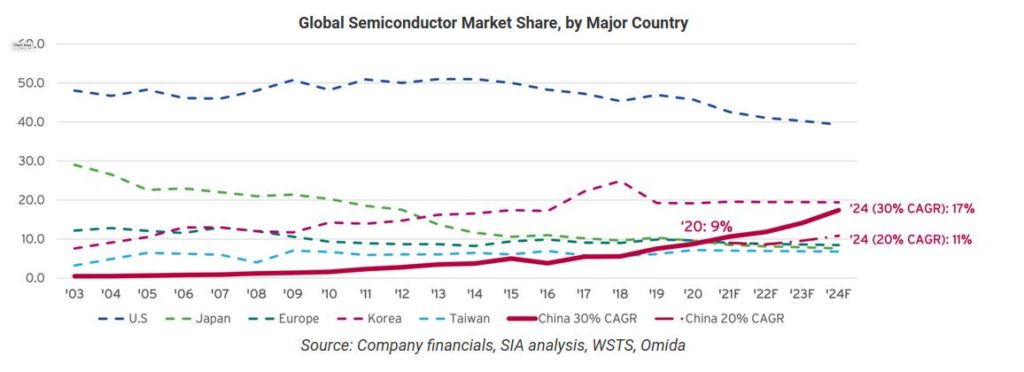
If China’s semiconductor development continues its strong momentum – maintaining 30% CAGR over the next three years – and assuming growth rates of industries in other countries stay the same, the Chinese semiconductor industry could generate $116 billion in annual revenue by 2024, capturing upwards of 17.4% of global market share [2]. This would place China behind only the United States and South Korea in global market share.

Chinese Semiconductor Firms Post Impressive Growth
Across all four subsegments of the Chinese semiconductor supply chain – fabless, IDM, foundry, and OSAT – Chinese firms recorded rapid increases in revenue last year, representing annual growth rates of 36%, 23%, 32%, 23%, respectively, based on an SIA analysis. Leading Chinese semiconductor firms are on track to expand domestically, and even globally, in several submarkets.
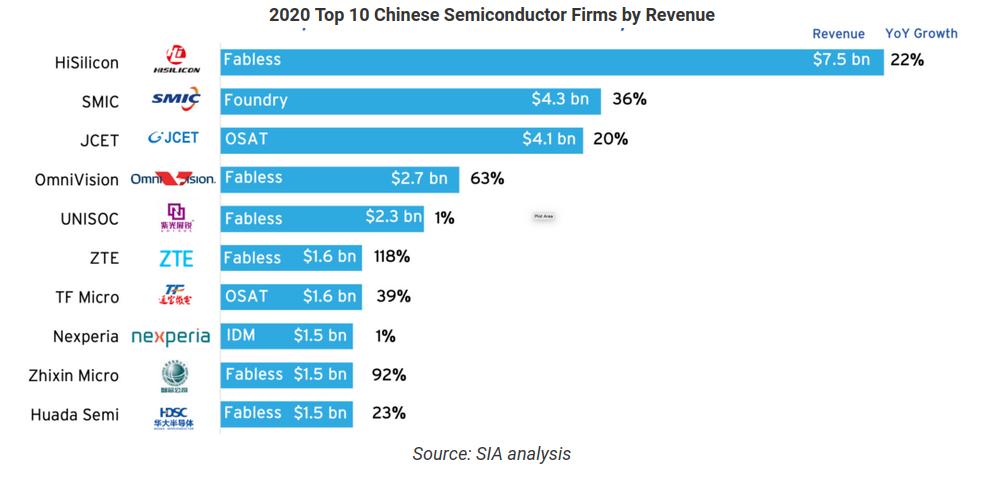
SIA analysis further shows that in 2020, China held an impressive 16% market share in the global fabless semiconductor segment, ranking third after the U.S. and Taiwan, and up from 10% in 2015 [7]. Benefiting from China’s massive consumer and 5G market, Huawei’s HiSilicon, China’s largest chip designer, generated nearly $10 billion in revenue in 2020, despite tightened export control restrictions (largely due to significant stockpiling suggested by official Chinese trade data). Other Chinese fabless firms, such as communications chip supplier UNISOC, MCU and NOR flash designer GigaDevice, fingerprint chip firm Goodix, and image sensor designers Galaxycore and OmniVision (a U.S.-headquartered corporation acquired by China), have all reported a 20-40% annual growth rate to become China’s top fabless firms. Moreover, in addition to supplying Chinese OMEs, GigaDevice, OmniVision, and Goodix have entered top 3 global smartphone vendors’ supply chains [8].
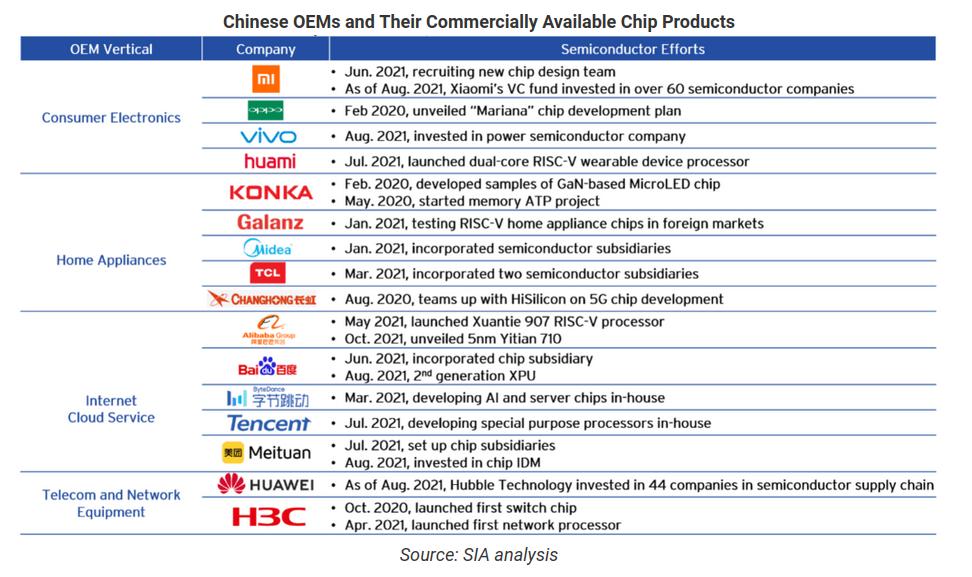
Meanwhile, Chinese consumer electronics and home appliance OEMs and leading internet firms have also been ramping up efforts to expand into the semiconductor sector by designing chips in-house and making investments in established semiconductor firms, with notable progress made in designing advanced chips and building domestic supply chains over the past two years [9].
China’s Chip Manufacturing Expansion Continues
China also maintains robust growth in building out its semiconductor manufacturing supply chain, with 28 additional fab construction projects totaling $26 billion in new planned funding announced in 2021 [10]. SMIC and other Chinese semiconductor leaders have further expanded their partnerships with local governments to construct additional joint venture fabs, with a focus on mature technology nodes [11]. Wafer manufacturing startups are continuing to spring up in the trailing-edge fabrication field, backed by government incentives [12].

On the chip manufacturing front, due to the inclusion of Huawei and SMIC on the U.S. government’s Entity List (China’s most advanced chip designer and foundry, respectively), the Chinese semiconductor industry has largely suspended advanced logic node manufacturing development and redirected most capital to mature fabrication technology. As a result of this change, from September 2020 to November 2021, Chinese wafer manufacturers have added nearly 500K wafer per month (WPM) capacities in trailing nodes (>=14nm), and only an additional 10K in capacity for advanced nodes. China’s wafer capacity increase alone accounted for 26% of the worldwide total [13]. In 2021, China also started commercial shipments of indigenously manufactured mobile 19nm DDR4 DRAM devices, and 64-layer 3D NAND Flash chips and started 128-layer products [14]. While the Chinese memory industry is still at an early stage of development, Chinese memory firms are expected to achieve a compound annual growth rate of 40-50% in output and become highly competitive over the next five years [15]. Regarding backend production, China is a global leader in outsourced assembly, packaging, and testing (OSAT), with its top three OSAT players collectively holding more than 35% of the global market share [16].
All indications are that China’s rapid growth in semiconductor chip sales is likely to continue due in large part to the unwavering commitment from the central government and robust policy support in the face of deteriorating U.S-China relations. While there remains a long way to go for China to catch up with existing industry leaders – especially in advanced node foundry production, equipment, and materials – the gap is expected to narrow over the next decade as Beijing sharpens its focus on semiconductor self-reliance during the current 14th Five-Year Plan [17].
From HERE
Chinese scientists call for plan to destroy Elon Musk’s Starlink satellites
Chinese military researchers have called for the development of a “hard kill” weapon to destroy Elon Musk’s Starlink satellite system if it threatens China’s national security.
The researchers drew attention to Starlink’s “huge potential for military applications” and the need for China to develop countermeasures to surveill, disable or even destroy the growing satellite megaconstellation. Their paper was published last month in the journal China’s Modern Defence Technology. A translated copy of the paper is available here.
There are ONLY 70 days left until catastrophe | Redacted with Clayton Morris
If you live in the West, you need to pay attention to this.
More Pictures from the Past









- Written by Ilya Tsukanov

A monkeypox virus particle captured via a coloured transmission electron micrograph UK HEALTH SECURITY AGENCY / SCIENCE PHOTO LIBRARY
The Russian military has spent over two months now detailing the extent and reach of the US military-biological research effort in Ukraine, revealing that the Pentagon has used the country as a testing ground for the study of deadly bioagents, and uncovering the tangled web of military, corporate, and political interests behind these activities.
Russian Radiation, Chemical, and Biological Defence Troops chief Igor Kirillov issued a fresh briefing on Friday, providing new information on US military biological activities in Ukraine, as well as details on what his troops know about monkeypox, a smallpox cousin which has caused a global health scare in recent weeks.
The Pentagon, he said, introduced a mandatory smallpox vaccination back in 2003, with US diplomats and medical personnel also required to be jabbed against the infectious disease.
“This indicates that the United States considers the smallpox pathogen a priority pathogenic agent for combat use, and ongoing vaccination measures are aimed at protecting their own military contingents”, Kirillov said.
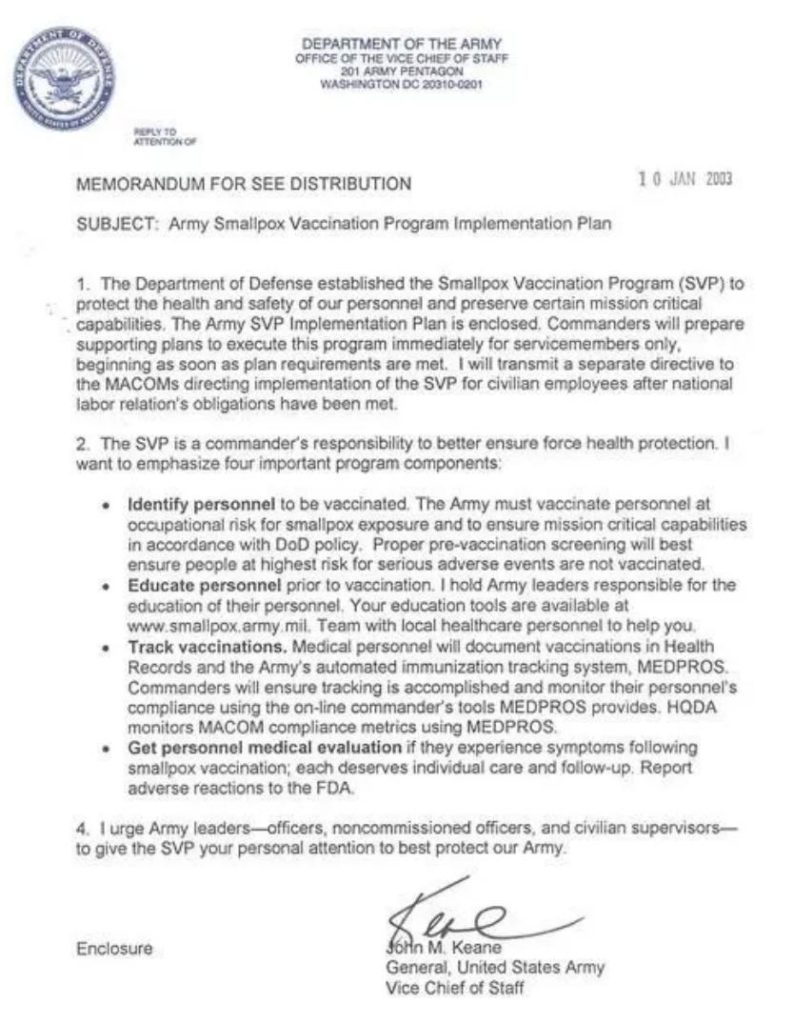
The complete 2003 US “Army Smallpox Preparedness and Vaccination Program Implementation Plan” document can be found here.
“The Pentagon’s interest in this infection is far from accidental. The return of the causative agent of smallpox would be a global catastrophe for all of humanity”, Kirillov suggested, emphasising that smallpox is 10 times more lethal than COVID-19.
Citing seized documentation, Kirillov revealed that American instructors trained employees of biolabs in Ukraine on how to respond to an emergency smallpox outbreak. Ukrainian-language documents on this training can be found here.
Smallpox was eradicated in the late 1970s thanks to global efforts, with vaccinations against the disease subsequently halted by most countries. However, health authorities in countries around the world have recently begun expressing concerns about monkeypox, after cases began to spread earlier this month.
Banana-Chocolate Chip Muffins
All natural fat free yogurt helps make these muffins moist and delicious!

Ingredients
- 3/4 cup mashed ripe bananas (about 2 small)
- 1/4 cup canola or vegetable oil
- 3/4 cup Yoplait® All Natural Fat Free plain yogurt (from 2-lb container)
- 1 egg
- 1 3/4 cups Gold Medal™ all-purpose flour
- 1/4 cup sugar
- 1 teaspoon baking powder
- 1 teaspoon baking soda
- 1/2 teaspoon salt
- 2/3 cup chocolate chips

A Secret Roswell Journal Becomes The Focus Of A New UFO Documentary
From HERE
I saw this article, and consider it interesting. I thought that I would share the article with everyone. -MM
A secret journal offers new clues about the nature of the alleged 1947 AD UFO crash at Roswell in the New Mexico desert, or does it? Before we kick off, this isn’t one of these Reddit stories that emerged from some basement decorated with posters of the Starship Enterprise and Chewbacca. Quite the opposite.
Live Science is one off the internet’s more respected academic media outlets and today they tell the story of a hitherto unknown personal diary belonging to Major Jesse Marcel, a head intelligence officer at the Roswell Army Air Field. The secret Roswell journal could change the narrative of this famous UFO event. In particular, the secret Roswell journal may contain secret coded observations that will help to “clarify” what really happened in Roswell in 1947 AD.
Marcel investigated the famous Roswell site in New Mexico where in 1947 a UFO is believed by many to have crashed. Furthermore, he claimed to have recovered some of the debris from whatever ditched in the desert that July night near the Roswell Army Air Field (RAAF). Newspaper photos at the time showed Marcel with pieces of metallic material and on the afternoon of July 8, 1947 AD he disclosed to the media “the crash and recovery of a flying disc.” However, the following day, an army official made a statement saying that a weather balloon had fallen to earth, “not a flying saucer.”
Will The Secret Roswell Journal Change Everything?
The Roswell story now takes a new turn since Major Marcel’s family revealed they had kept his personal secret Roswell journal which contains “hitherto unknown clues about the crash.”
The secret diary and its equally secret contents will soon be presented on History Channel´s History’s Greatest Mysteries series in an episode called Roswell: The First Witness .
The episode was released on December 12th, Saturday, 2020 AD.
The show host, Ben Smith, is a former CIA operative and the show’s lead investigator. He thinks it is very unusual that the day after the government claimed they had recovered a UFO they switched stories and maintained it was merely “a weather balloon,” Smith told Live Science .
This story is another in a long line of recent reports pertaining to UFOs. According to The Guardian in 2017 AD a former Pentagon official confirmed the existence of a federal agency that had been “secretly investigating UFOs since 2007.”
Then, in 2018, U.S. Navy pilots reported “three encounters with fast-moving UAP, or unidentified aerial phenomena” better known to us civies as UFOs.
And building up this emerging alien narrative, officially declassified videos of these occurrences were published in April of this year, as previously reported on Live Science .
Secret Roswell Journal: A Problem Of Might, May And Could
Let´s now return to Major Jesse Marcel, the author of the secret Roswell journal.
He investigated the site at Roswell and recovered what he believed to be debris from a flying saucer . In 1997 AD, Time published an article saying Marcel told an interviewer at the time that “he believed” the object that crashed in the New Mexico desert had extraterrestrial origins.
Now, a forensic analysis of Marcel´s secret Roswell journal “could reveal” coded messages that he wrote about the crash at the time that it happened, Ben Smith said.
This application of the word “could” will no doubt have skeptics raging, because they all know what’s most probably coming here. If the diary really contained any actual evidence that the Roswell incident was nothing more than a collapsed weather balloon we would certainly have heard about it by now. Unless of course thousands of unpaid interns and staff at the network have all kept quiet, doubters can argue. Perhaps the skeptics greatest argument is presented in plain sight in the newspaper photograph of Marcel on the evening of the crash. To all but the most committed believers in extraterrestrials it is perfectly clear that Marcel is holding a piece of a crumpled (crashed) weather balloon.
When the History Channel episode airs and unavoidably “no evidence” of extraterrestrials is offered, perhaps then maybe some “believers” will consider the content of the Ancient Origins news article I wrote about this only last month.
A team of Oxford University researchers recently applied statistics to the question “are we alone” and concluded that “life on earth is probably a unique universal phenomena, and that it´s ‘extremely unlikely’ that any other intelligent life exists anywhere else in the universe.” This is a profound claim that sceptics love and believers loathe.
And the same extreme opinions are likely to flood across social media channels when the details of Major Marcel’s secret Roswell journal are revealed.
US Biolabs in Nigeria
Kirillov took note of the World Health Organisation’s recent determination that the causative agent of the monkeypox virus being met today originated in Nigeria, and pointed out that this is “another state upon whose territory the United States has deployed its biological infrastructure”.
“According to available information, there are at least four US-controlled biolabs” in the African nation”, Kirillov said.
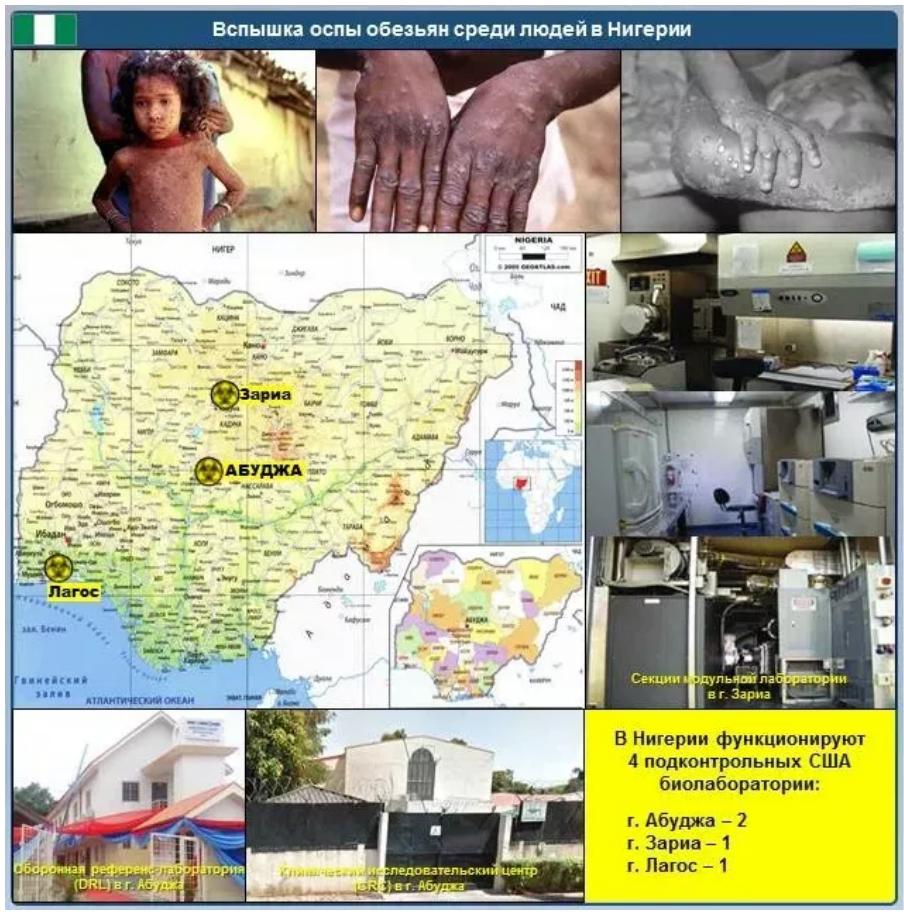
Kirillov also pointed to media reports on the 2021 Munich Security Conference-Nuclear Threat Initiative simulation modelling the outbreak of a bioengineered, highly deadly strain of monkeypox by terrorists, calling the exercise “an odd coincidence which needs additional verification by specialists”.

The officer emphasised that against the backdrop of repeated US violations of biosafety requirements and evidence of the careless storage of pathogenic biomaterials, including smallpox, the WHO should investigate the activities of US-funded labs in the cities of Abuja, Zaria, and Lagos, Nigeria, and inform the international community on their findings.
The RCB Defence Troops chief also expressed concerns about the safety of smallpox virus samples inside the United States itself.
“The lack of proper control and the violation of biosecurity requirements in the United States could lead to the use of this pathogen for terrorist purposes. Between 2014 and 2021, unaccounted for vials containing the virus were repeatedly found in the laboratories of the US Food and Drug Administration, the US Army Medical Research Institute of Infectious Diseases in Maryland, and the Centre for Vaccine Research in Pennsylvania”, Kirillov said.
Kirillov stressed that the work of these labs violated a 1996 resolution by the WHO, which prohibited smallpox’s causative agent from being stored in all but one US-based laboratory – the Centres for Disease Control and Prevention in Atlanta.
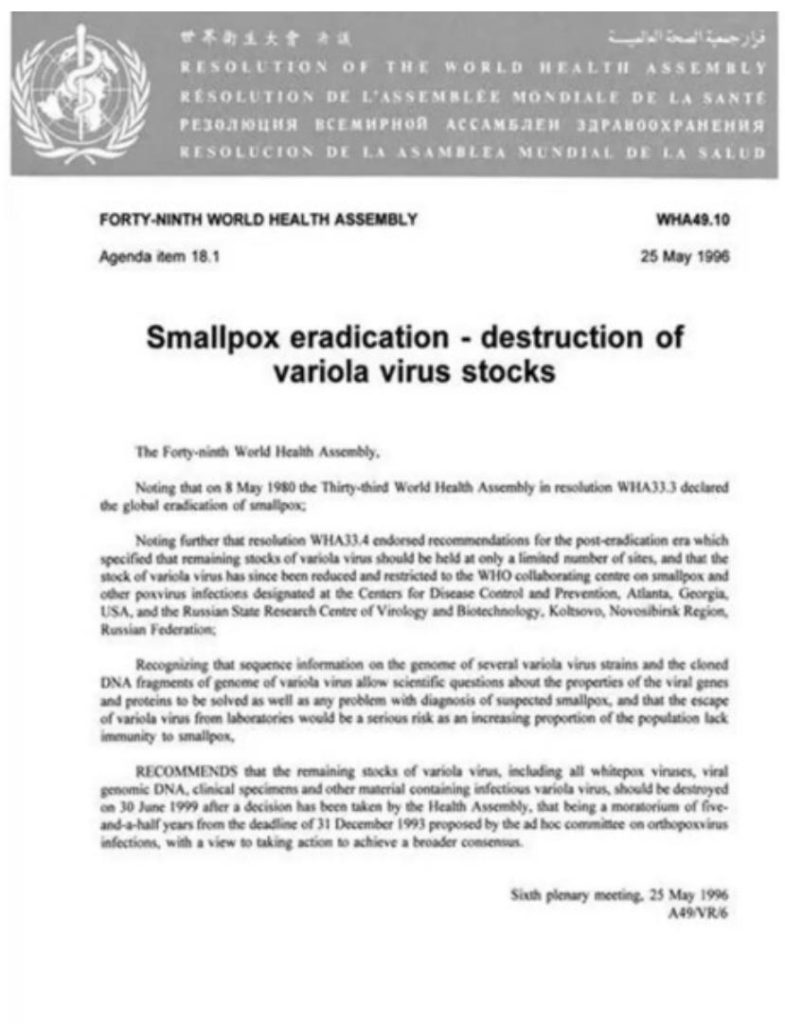
New Details on Pentagon-Funded Labs in Ukraine
During Friday’s presentation, Kirillov also provided new documentation on the operation of nearly a dozen military-biological projects organised by the Pentagon in Ukraine, including deadly agents and “economically significant” infections, funded to the tune of over $8.01 million between 2008 and 2019.
The officer drew attention to a 2007 memorandum prepared by the Office of the US Secretary of Defence regarding UP-2, a project mapping dangerous pathogens in Ukraine, whose “main purpose”, in Kirillov’s words, was “to collect information on the molecular composition of pathogens characteristic to Ukraine, and to transfer strain samples”.
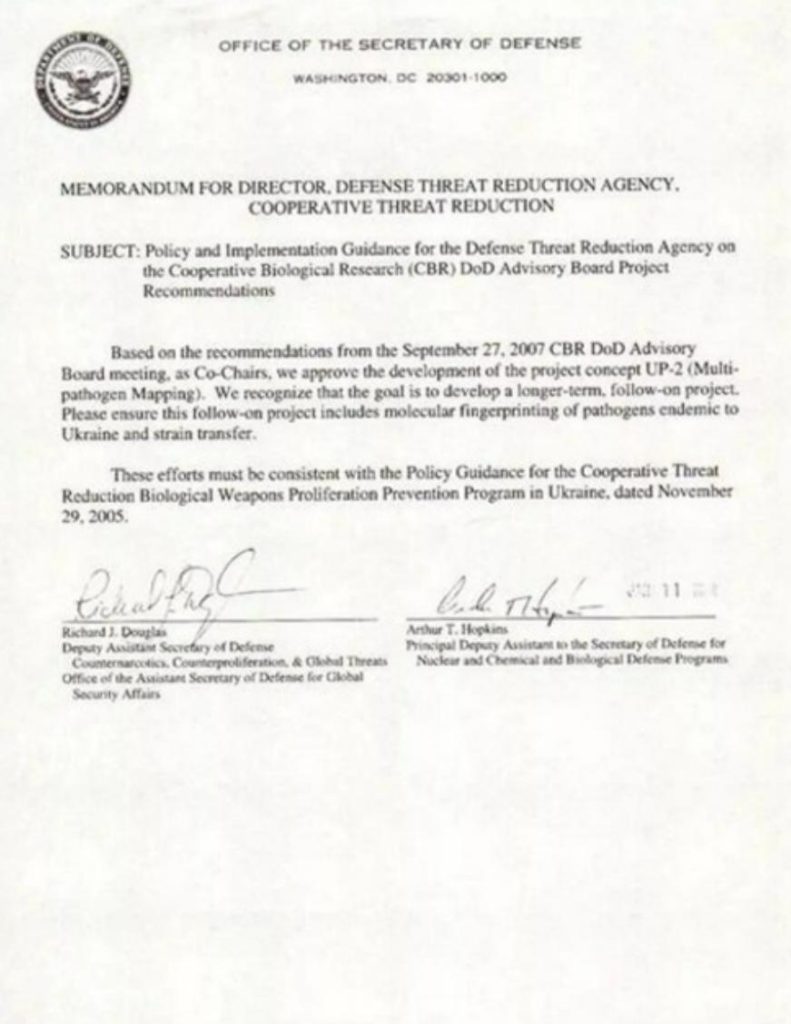
The complete six-page “Partner Project Agreement” on UP-2 can be found here.
A similar memorandum was prepared for project UP-1, studying rickettsia and other diseases spread by arthropods, Kirillov said, pointing out that the document required for all of the dangerous pathogens collected to be transferred to the Central Reference Laboratory in Kiev, allowing them to be transferred to the US.
The “Partner Project Agreement” on project UP-1 can be found here.

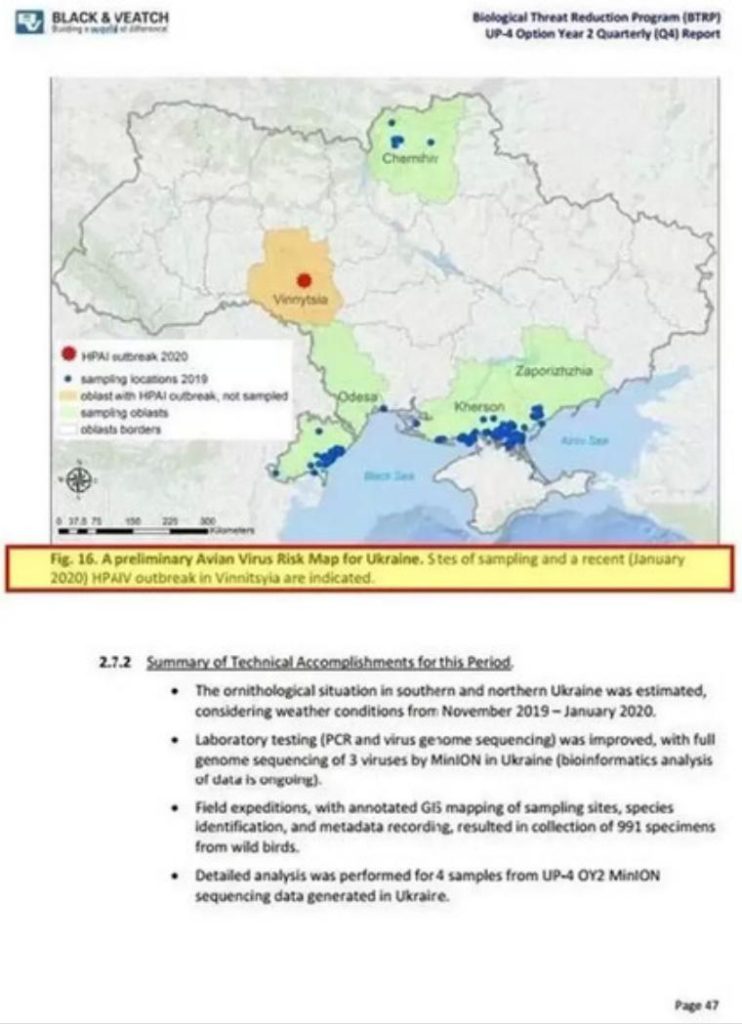
Excerpt from Defense Threat Reduction Agency report on project UP-4.
Nine pages of the 50+ page DTRA report, prepared by Pentagon contractor Black & Veatch Special Projects Corp in collaboration with Metabiota, can be found here.
The documents released Friday by the RCB Defence Troops also included a detailed 2019 Black & Veatch report for the DTRA detailing its activities in Ukraine, including work on some 19 separate research projects, and collaboration with a host of Ukrainian and international organisations, including the Ukrainian Ministry of Health, the USDA, the CDC, several American universities, and Western pharmaceutical giants. Dozens of pages from the 63-page document, containing a goldmine of important details, can be found and downloaded here.
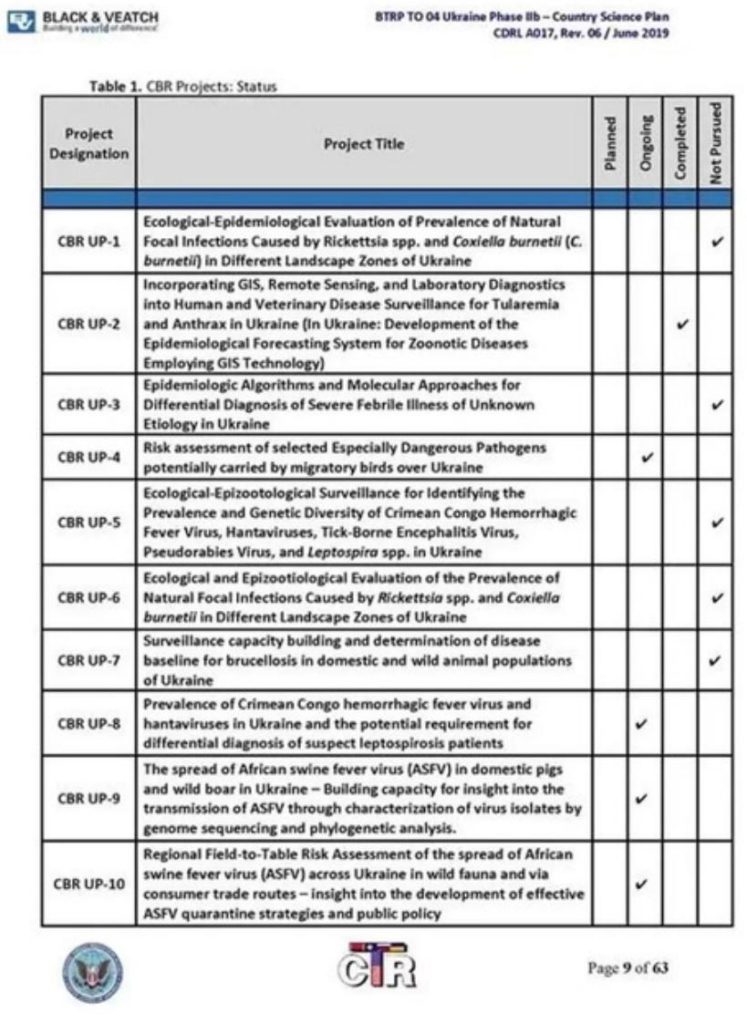
Chinese Propaganda Posters From The Cultural Revolution Ages, 1960s-1970s

In 1966 Mao Zedong, the Communist leader of China, started a political campaign that became known as the Cultural Revolution (1966-1976). Mao called on China’s youth to help him purge capitalist influences and bourgeois thinking in government, teaching, the media and arts, and to reinvigorate the revolutionary spirit.
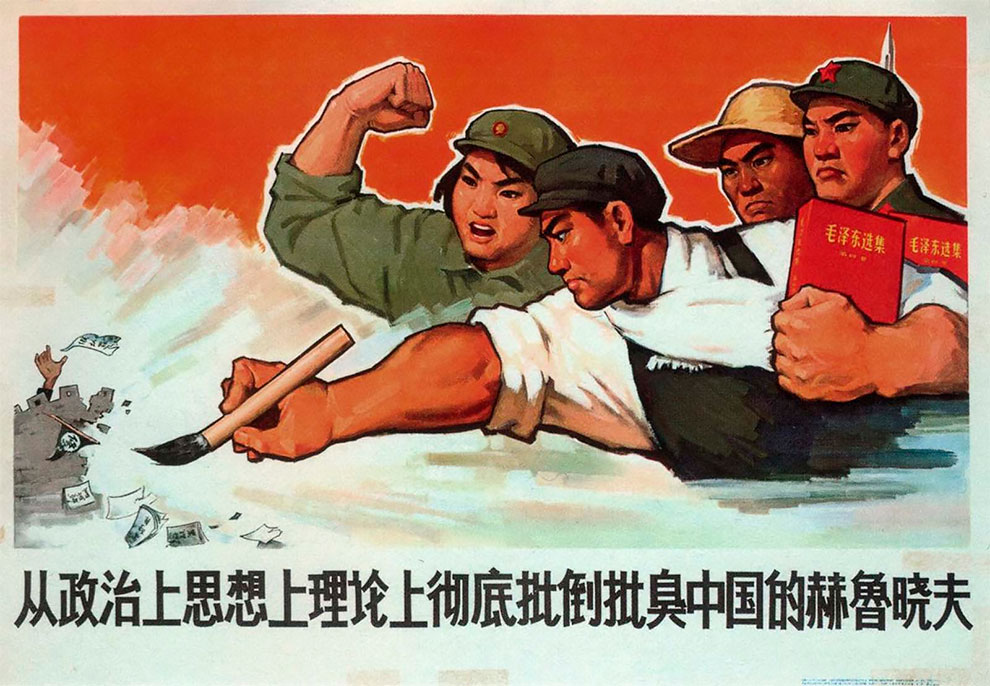
Calling themselves The Red Guards, radical students set out to destroy the “four olds”: old ideas, customs, habits and culture. They spearheaded the interrogation, humiliation and beatings of teachers and intellectuals, and traveled the country destroying cultural heritage. During the Cultural Revolution traditional artists were condemned as counter-revolutionaries and their work destroyed. A new style of art was required that supported the Maoist line and served the worker, peasant and soldier.

The decade was marked by purges and power struggles at the upper echelons of government, and the mobilization of masses of young people to enforce Maoist thought. One of the primary vessels for disseminating instructions and models of behavior was propaganda art. Vivid posters were created to inspire citizens to put forth their labor towards agriculture, industry and national defense, as well as concerns such as hygiene and family planning.

Slogans are often used alongside imagery in posters, usually written in bold, Chinese script. They include pro-revolution messages about “working hard”, “uniting for victory” and “working towards the general communist goal. “Bright” colors are used in many of the posters and red appears a lot as it is the color of communism and revolution. Much of the work that came out of the Cultural Revolution is attributed to committees or groups, rather than individuals. Thousands of copies of the posters were printed and sold cheaply as the establishment at the time wanted the posters to be something that everyone should have on their walls at home. Many of the posters were painted by hand and then printed as lithographs, a process involving using stone, oil and chemicals to create prints.



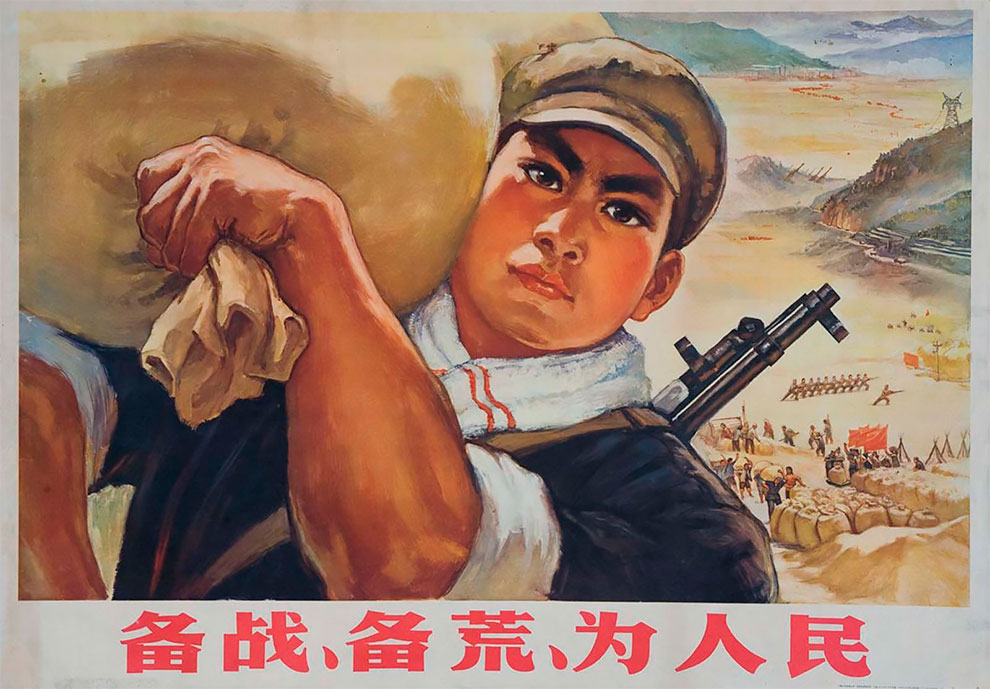


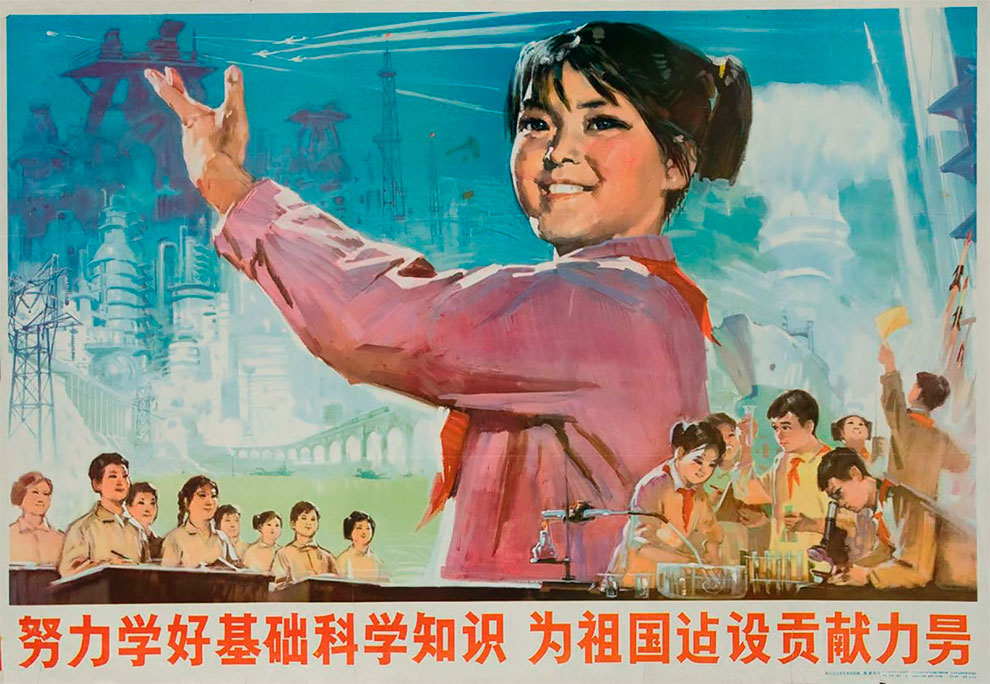


Intel: Ukraine Losing 1500 Soldiers per day to death, wounding, capture, surrender, or desertion
“Intercepted communications from the Ukrainian command reveal their aim to build a layered defense from Poltava through Dnepropetrovsk, Zaporozhia, Krivoy Rog, and Nikolaev – which happens to be a shield for the already fortified Odessa. None of that guarantees success against the incoming Russian onslaught.
It’s always important to remember that Operation Z started on February 24 with around 150,000 or so fighters – and definitely not Russia’s elite forces. And yet they liberated Mariupol and destroyed the elite neo-Nazi Azov battalion in a matter of only fifty days, cleaning up a city of 400,000 people with minimal casualties.
While fighting a real war on the ground – not those indiscriminate US bombings from the air – in a huge country against a large army, facing multiple technical, financial and logistical challenges, the Russians also managed to liberate Kherson, Zaporizhia and virtually the whole area of the ‘baby twins,’ the popular republics of Donetsk and Luhansk.
Russia’s ground forces commander, General Aleksandr Dvornikov, has turbo-charged missile, artillery and air strikes to a pace five times faster than during the first phase of Operation Z, while the Ukrainians, overall, are low or very low on fuel, ammo for artillery, trained specialists, drones, and radars.
What American armchair and TV generals simply cannot comprehend is that in Russia’s view of this war – which military expert Andrei Martyanov defines as a “combined arms and police operation” – the two top targets are the destruction of all military assets of the enemy while preserving the life of its own soldiers.
So while losing tanks is not a big deal for Moscow, losing lives is. And that accounts for those massive Russian bombings; each military target must be conclusively destroyed. Precision strikes are crucial.
There is a raging debate among Russian military experts on why the Ministry of Defense does not go for a fast strategic victory. They could have reduced Ukraine to rubble – American style – in no time. That’s not going to happen. The Russians prefer to advance slowly and surely, in a sort of steamroller pattern. They only advance after sappers have fully surveilled the terrain; after all there are mines everywhere.
The overall pattern is unmistakable, whatever the NATO spin barrage. Ukrainian losses are becoming exponential – as many as 1,500 killed or wounded each day, everyday. If there are 50,000 Ukrainians in the several Donbass cauldrons, they will be gone by the end of June.
Ukraine must have lost as many as 20,000 soldiers in and around Mariupol alone. That’s a massive military defeat, largely surpassing Debaltsevo in 2015 and previously Ilovaisk in 2014. The losses near Izyum may be even higher than in Mariupol. And now come the losses in the Severodonetsk corner.
We’re talking here about the best Ukrainian forces. It doesn’t even matter that only 70 percent of Western weapons sent by NATO ever make it to the battlefield: the major problem is that the best soldiers are going…going…gone, and won’t be replaced. Azov neo-Nazis, the 24th Brigade, the 36th Brigade, various Air Assault brigades – they all suffered losses of 60+ percent or have been completely demolished.
So the key question, as several Russian military experts have stressed, is not when Kiev will ‘lose’ as a point of no return; it is how many soldiers Moscow is prepared to lose to get to this point.
The entire Ukrainian defense is based on artillery. So the key battles ahead involve long-range artillery. There will be problems, because the US is about to deliver M270 MLRS systems with precision-guided ammunition, capable of hitting targets at a distance of up to 70 kilometers or more.
Russia, though, has a counterpunch: the Hermes Small Operational-Tactical Complex, using high precision munitions, possibility of laser guidance, and a range of more than 100 kilometers. And they can work in conjunction with the already mass-produced Pantsir air defense systems….
…the imminent loss of Severodonetsk and Lysichansk will ring serious alarm bells in Washington and Brussels, because that will represent the beginning of the end of the current regime in Kiev. And that, for all practical purposes – and beyond all the lofty rhetoric of ‘the west stands with you’ – means heavy players won’t be exactly encouraged to bet on a sinking ship…
…Zelensky will be fine. He’s protected by British and American special forces. The family is reportedly living in an $8 million mansion in Israel. He owns a $34 million villa in Miami Beach, and another in Tuscany. Average Ukrainians were lied to, robbed, and in many cases, murdered, by the Kiev gang he presides over – oligarchs, security service (SBU) fanatics, neo-Nazis. And those Ukrainians that remain (10 million have already fled) will continue to be treated as expendable.”
Put simply, Ukraine is losing the war. They are losing fast. They are losing big.
Short of direct NATO intervention, there is no hope at all for Ukraine to prevail militarily.
Ukraine’s Own Security Service Warned About Dangers of Cooperation With US
Friday’s document dump also included a letter by a Security Service of Ukraine (SBU) officer expressing concern about epidemiological threats posed by US involvement in biological activities in Ukraine.
The letter, written by Col. A.A. Lemeshov, deputy head of the SBU Directorate in the Kherson Region and addressed to Col G.I. Kuznetsov, deputy chief of the Anti-Terrorist Centre and Analytical Department head Col. S.I. Shanaida, was sent on 28 February 2017, and focused on the safety of Ukrainian laboratories and the threat of biological terrorism.
Lemeshov bluntly warned that;
"recently, the potential threat to the epidemiological and epizootic situation in our country has taken on increasing importance, due to attempts by the US Defence Threat Reduction Agency through the Black & Veatch Special Projects Corp to establish control over the operations of microbiological laboratories in Ukraine for the study of pathogens of especially dangerous infectious diseases which can be used to create new biological weapons or improve old ones".
The officer stressed that “in order to maintain the stability of biosecurity in Ukraine, and to prevent attempts to accumulate pathogen samples in its territories under the pretext of ‘studying the specifics of local strains and determining the degree of virulence of the obtained samples among the population’, it is advisable to track the activity of Black & Veatch Special Project Corp’s ‘programmes of involvement in joint biological activities'”.
The original, Ukrainian-language document can be found here. A Russian-language translation can be found here.
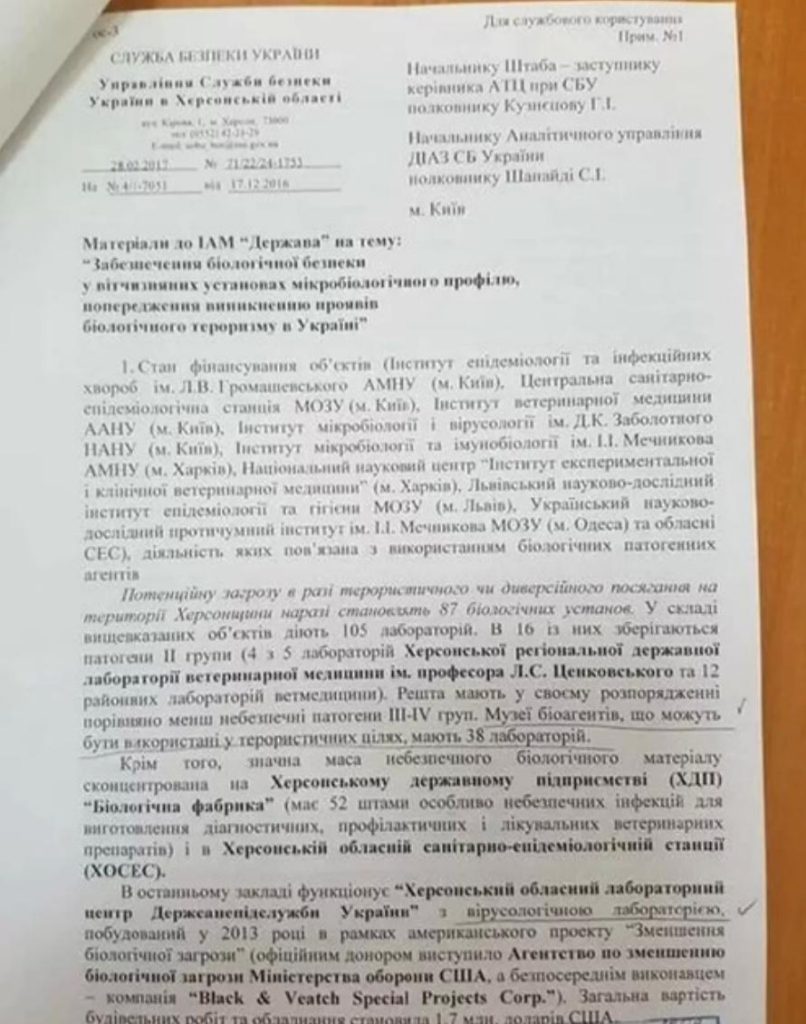
Kirillov’s RCB Defence Troops have spent months briefing media on the extent of US military biological activities in Ukraine, citing seized documents and other materials to reveal how the Pentagon, US government agencies and corporations have cooperated with their Ukrainian counterparts to engage in dangerous research on Ukrainian territory.
Earlier this month, Russian Senator Konstantin Kosachev indicated that Moscow intends to initiate a formal probe at the United Nations into possible US violations of the Biological Weapons Convention in Ukraine.
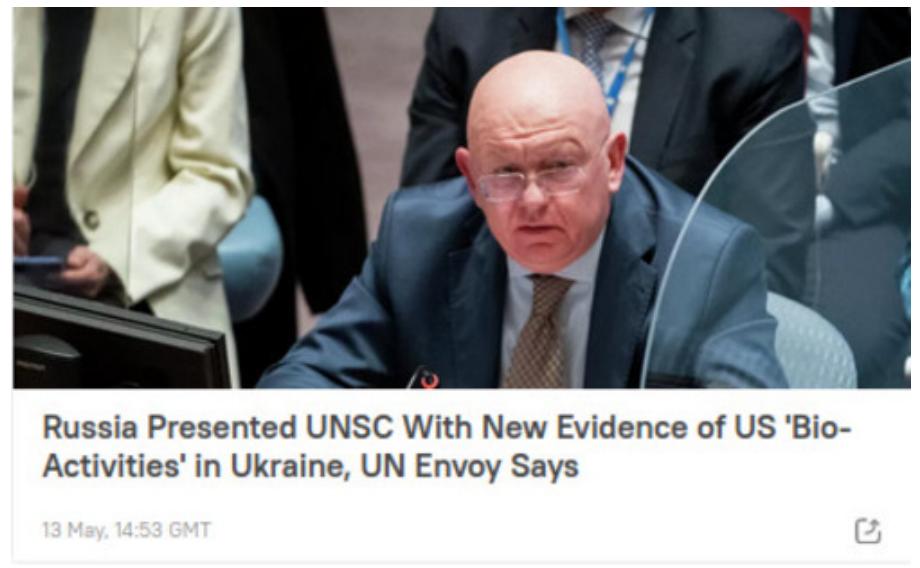
In a document-filled briefing earlier this month, Kirillov revealed that in addition to its use by the US military to study deadly pathogens, Ukraine has acted as a guinea pig for Western drug companies, including Pfizer, Battelle, Gilead, Dynaport Vaccine, AbbVie, Eli Lilly & Co, Merck, Moderna, and others, to test medicines which could not be tested in their home countries for safety reasons.
The Danger of Underestimating Russia
When I was a wee young thing on Wall Street, I would hear a warning regularly from colleagues at Lazard, about “believing your own PR”. Interesting, this phrase was not a part of the general Wall Street lexicon. It was important at Lazard because it was a top M&A boutique (this was in the days of Felix Rohatyn) and therefore made its living off managing the abnormal psychology of CEOs. Specifically, the firm’s deal flow depended on maintaining these personal relationships. Therefore Lazard partners did what they could to prevent CEO self-destruction.
Unfortunately, it’s become painfully obvious that in just the same way the West has become hoist on its Russia sanctions petard, so too has it blinded itself with its anti-Russia propaganda. The jingoism and fabrications have become so extreme and relentless that any erstwhile realist has to go to non-mainstream, or at least non-US/non-European MSM sources. And even then, if you don’t buy what Ukraine is spinning, and is being amplified uncritically in the Western media, you must be some sort of turncoat.
Admittedly, we’re seeing some signs of cracks, such as a New York Times editorial telling Team Biden that Ukraine needs to negotiate. Similarly, at the World Economic Forum, Henry Kissinger also said negotiations needed to start in the next two months, and Italy has devised a proposal and even sent it to Russia.
But there’s massive denial about facts on the ground. The militias and Russia have cleared Mariupol, control the Donetsk oblast and are very close to taking Lugansk…and with it, thousands to as many as 20,000 of Ukraine’s best fighting forces. Russia has started shelling military targets in Zaporizhzhia, a major industrial city in the Zaporizhzhia oblast, just to the west of the Donetsk oblast on the Black Sea coast.
Kissinger proposed returning to status quo ante, when Russia’s red lines as of the end of March, at the time of the last serious negotiating session in Istanbul, were much higher than that. Russia had also made clear that the longer the war went on, the more its demands would increase. Yet Italy, which is getting unhappy about the costs of the conflict, is also now seeking a settlement and apparently put forward a proposal. I have yet to see it but it’s already been rejected by former President and deputy chairman Dmitry Medvedev….of all things on Telegram. Admittedly Medvedev is speaking out of school; Lavrov said the government was studying it. Nevertheless (see starting at 6:50, courtesy Alex Christoforu):
But no, it’s just pure stream of consciousness by European graphomaniacs….One has the feeling it was prepared not by diplomats but by local political analysts who have read too many provincial newspapers and use only Ukrainian fakes.
Medvedev then goes through three of the four major points and dismisses each. For instance:
3. The full autonomy of Crimea within Ukraine This is direct boorishness toward Russia, a threat to its territorial integrity and a pretext for starting a full-fledged war. There is not and never will be a political force in Russia that would agree even to discuss the fate of Crimea. That would be a national betrayal. There is no point in analyzing it further. This is just an attempt to save Ukraine some face….However, Ukraine does not want to negotiate at all. They chose to forget about the Russian draft peace treaty long ago. It is as if there is no such thing at all. They are counting only on the flow of money and weapons from Western countries. War until the victorious end. In vain.
The cognitive dissonance is impressive. German chancellor Olaf Scholz and US Defense Secretary LLoyd Austin both called Russia seeking a ceasefire. You don’t do that if you are winning. But the Western media has so inflated the position of Ukraine and its supposedly invincible military that keeps kicking Russian ass that it would take a massive change in media messaging just to get the public to accept that Ukraine would have to cede territory, let alone make other concessions like neutrality.
The US and Ukraine have both proven so “agreement incapable” that Russia has likely concluded it needs to take matters into its own hands and execute rather than negotiate demilitarization and denazification. In this blogger’s humble opinion, that means at a minimum taking Odessa, since that’s another big nest of Azovities and other nasty types. And as much as Russia’s seemingly leisurely prosecution of the war has enabled the Western press to denigrate it, it’s probably the only sound way to deal with Ukraine’s bunkers in Donbass. Plus the sanctions blowback gets ever more painful as the military campaign grinds on.
Most of this will be familiar ground to regular readers. I wanted to widen the frame a bit. The Western ‘tude towards Russia, that it should be willing to go full Emily Litella “Never mind” and simply walk away from its successes so far and its underlying security concerns, seems to be rooted in US/Anglo chauvinism and persistent underestimation of Russia. If you managed to miss it yesterday, be sure to see Dimitri Orlov’s The Secret American Plan to Make Russia Great Again.
Below are two different examples of US misappraisal. The first, embedded at the end of this post, is the latest Defense Intelligence Agency Threat Estimate. We wrote about it shortly after it was presented, in early May. What seemed noteworthy then was its pointed failure to say much about Ukraine, particularly its capabilities and prospects. This seemed like damning with faint praise. We also took note of quite a few reality-challenged claims, such as Russia wanting to challenge the US and undermine American democracy.
Reader scarnoc voiced broader concerns:
It is quite frightening to me that this is a threat assessment that is used to explain things to congress-lizards and their staffers. The assessment underplays Russian conventional and strategic military capabilities. Current capabilities (particularly strategic nuclear ones) are downplayed or explained as possible future developments instead of current realities.There is a false pretense that sanctions are slowing or harming Russian military-industrial output. There is no detailed description of Russia’s very public and oft-repeated war aims, or of their medium and long term diplomatic aims, none of which have been withdrawn or changed by Moscow. The Russians still intend to push NATO back to its 90s borders, for example. If anything, those medium/long term goals have expanded. The special relationship between Beijing and Moscow is described as a series of formal agreements instead of an informal but very close ‘friendship’ that both sides have repeatedly called ‘better than an alliance’. A relatively uninformed reader would conclude that there is space between Mr. Xi and Mr. Putin that USA can exploit. Lizards and their staffers, being creatures who live primarily on TV news, are by definition uninformed, and they will draw all the wrong lessons from these parts of the report. The section on Iran does not mention the depth of friendship and cooperation between Iran and Russia, nor the depth of Iran’s growing relationship with PRC. There is little in this assessment that explains to the reader just how immense the Russian threat to American unipolarity is right now, today. Given how American congressional and executive leadership talks about Russia like it needs to be completely erased and destroyed, I don’t see any mechanism in front of us that will de-escalate this conflict. Russia will continue to act in accordance with it’s own power and sense of national destiny, stupid American elites will continue to discount and misunderstand that Russian power and overestimate their own power, until at some point we arrive at nuclear exchange. I really, dearly hope I am wrong. I’m putting curtains up in the bunker at this point.
Another example is Putin’s speech at the 2007 Munich Security Conference. This is an important speech and I urge you to watch it in full.
This event was in the time frame where Putin still harbored hopes of Russia being able to operate like a normal advanced economy and having cooperative relations with other countries. But those in the US/NATO defense community who hadn’t already taken a dislike to him already used this talk as an excuse. Putin had the temerity to speak directly as opposed to deferentially, pointed out the world was moving to multipolarity by virtue of the growing economic heft of countries like China and India, and worst of all, that the US was threatening the notion of international law by launching wars without getting UN approval. That in turn jeopardized stability since no country could feel safe. I am sure quite a few leaders year later took note of how Gadaffi was our friend until suddenly he wasn’t.
Putin also used the bully pulpit to call out NATO installing new bases closer to Russia even as Russia was honoring commitments as a provocation that reduced, not enhanced security. And he also called out how WTO/Western development programs for poor countries asked them to open their markets, particularly to subsidized agricultural goods, yet held back higher-tech goods:
On the one hand, financial resources are allocated for programs to help the world’s poorest countries – and at times substantial financial resources. But – and many here know this – linked with the development of the same donor country’s companies….one hand distributes charitable help and the other hand not only preserves economic backwardness but also reaps the profits thereof.
Ouch.
John McCain reportedly looked daggers at Putin the entire time. Apparently pointing out what should have been an obvious trajectory of events, as well as risks of the current course of US action, was seen as presumptuous. Countries like Russia are supposed to know their place. The reason Putin’s remarks stung was that they were on target. The US of 2007 wasn’t even secure enough to laugh off Putin’s observations as that of an arriviste who didn’t know enough of secret dealings to render judgement.
And the US and the West continue to act to our own detriment out of a distorted sense of amour propre.
The Prisoner 14
Here it is again, in case you missed it.
“Living in Harmony”.
Do you want more?
You can find more articles related to this in my latest index; A New Beginning. And in it are elements of the old, some elements regarding the transition, and some elements that look towards the future.
New Beginnings 4.
Articles & Links
Master Index.
- You can start reading the articles by going HERE.
- You can visit the Index Page HERE to explore by article subject.
- You can also ask the author some questions. You can go HERE to find out how to go about this.
- You can find out more about the author HERE.
- If you have concerns or complaints, you can go HERE.
- If you want to make a donation, you can go HERE.
.



I’m afraid that massive destruction will be painful, but necessary. And we see it not only in the US, but also in many parts of Europe. Cities made uninhabitable for a variety of reasons, people with dead-end jobs with no meaning, and that do not provide a way to earn a living. Sadly, change will not be gradual, there will be widespread destruction of urban centers, and the survivors will slowly flow out into the small towns.
Many USA media reports of China opening back up. Looks like the current vibe is getting a little more optimistic.
Really? China opening back up? Seriously?
Someone had better tell my local government. China is still at DEFCON 2.
Current policy has not changed; it is anyone can enter China with a visa. The rules are two weeks in a government run quarantine facility, and two weeks in a quarantine hotel. Mandatory multiple virus checks while at the hotel, and the visitor must pay for all the monitoring. There are certain exceptions, but they are very strict. I just checked my APP, that that policy is still in effect.
Where did you get this “news”? Epoch Times? NY Post? CNN? BBC? Zero Hedge?
It’s not going to “open up” (i.e. regain the pre-covid entry procedures) until the threat of bio-weapons has ended. I do not see that happening any time soon. My current visa is stating post-2024. So I wouldn’t put too much faith in Western “news”. Instead, I would read the official Chinese entry procedures on the government web page HERE.
Get it direct “from the horse’s mouth” instead of reading propaganda.
I did compare the government information against the latest Western information. They DO NOT MATCH.
Propaganda
Official Chinese Policy